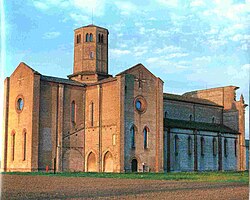San Martino di Bocci Monastery
| Cistercian Abbey of San Martino di Bocci | |
|---|---|
 The abbey church |
|
| location |
region of Emilia-Romagna province of Parma |
| Coordinates: | 44 ° 51 '22 " N , 10 ° 20' 48" E |
| Serial number according to Janauschek |
693 |
| Patronage | St. Martin |
| founding year | 1298 |
| Year of dissolution / annulment |
1810 |
| Mother monastery | Chiaravalle della Colomba monastery |
| Primary Abbey | Clairvaux Monastery |
|
Daughter monasteries |
no |
Monastery of San Martino di Bocci (Valserena, S. Martin de'Bocci; Latin Abbatia Valserena vel Abbatia Paradigna ) was a Cistercian abbey in Emilia-Romagna , Italy . The monastery, which is also known under the false name Certosa di Parma and was the subject of the famous novel The Charterhouse of Parma von Stendhal , must not be confused with the Trappist convent Valserena in Guardistallo ( province of Pisa ). It is located around 6 km north of Parma in the province of the same name in the Paradigna district near the road to Colorno .
history
The foundation was made in 1298 by the suburbicarian Bishop of Sabina , Cardinal Gerardo Bianchi, who endowed the monastery in the following year with goods, with the permission of Pope Boniface VIII. ; however, the settlement by the founding convent from the monastery Chiaravalle della Colomba did not take place until some time later, in 1303 at the latest. Thus the monastery belonged to the filiation of the Clairvaux primary abbey . The monastery was built in the religious style. The church was consecrated in 1385. In 1497 it joined the Italian Cistercian Congregation, but came to the Roman Congregation in 1786 with the two other monasteries of the Duchy of Parma and Piacenza, Chiaravalle della Colomba and Quartazzola or Ponte Trebbia. At that time there were barely 10 monks , caused by the Coming introduced around 1496 . During the Napoleonic era, the monastery came to an end in 1810. A tomato canning factory has been set up in the church, the cloister has disappeared and the chapter house has been turned into a granary and the rest of the buildings have been converted into apartments. In 1964 the church was taken over by the state. Today the abbey is a study and archive center of the University of Parma .
Plant and buildings
The monastery was built in the Gothic forms of the early 14th century in the style of the Cistercian complexes (cruciform basilica with transept, octagonal crossing tower and rectangular choir with frescoes by Baglione). The enclosure is south (right) of the church. The complex was changed in the style of Rococo and Empire .
literature
- Balduino Gustavo Bedini, Breve prospetto delle Abazie Cistercensi d'Italia , oO. (Casamari), 1964, pp. 172-173, without ISBN.
- Sergio Stocchi, Romanische Emilia-Romagna , Echter Verlag Würzburg 1986, p. 261, ISBN 3-429-01010-1 .
- Silvia Testa, Piero Rimoldi, Abbazie e Siti Cistercensi in Italia 1120-2018 , Arti Grafiche Parma, 2018, ISBN 978-8894247886 .